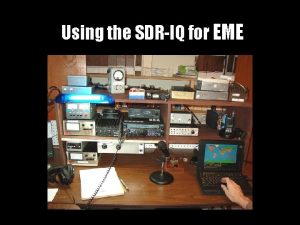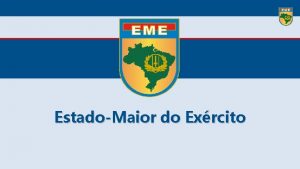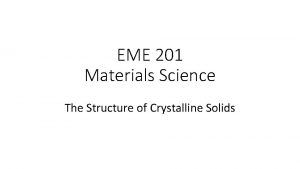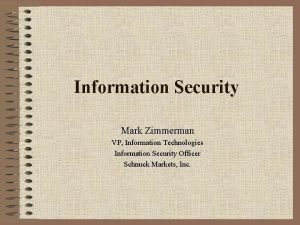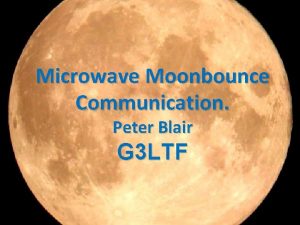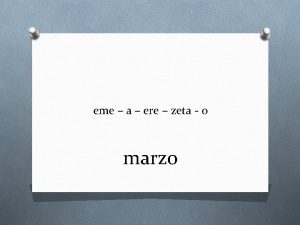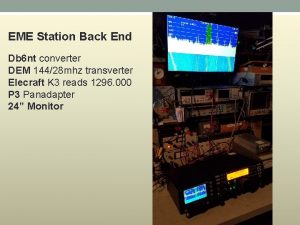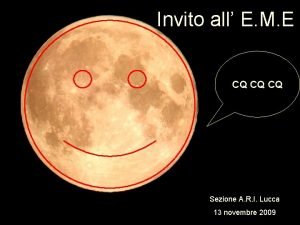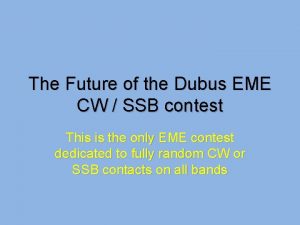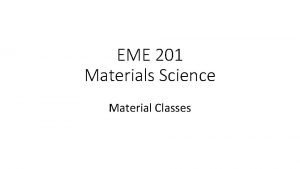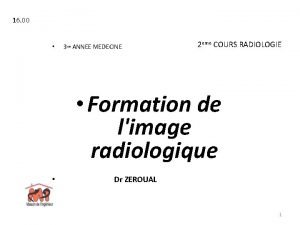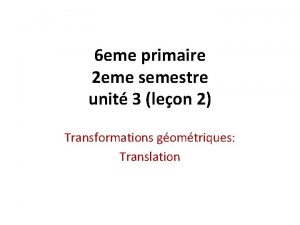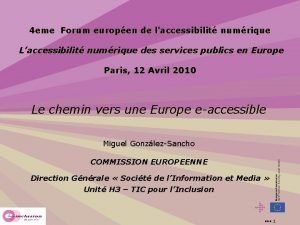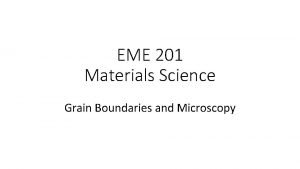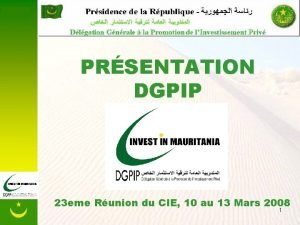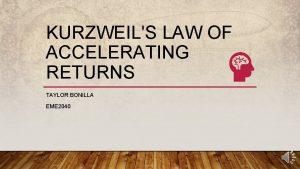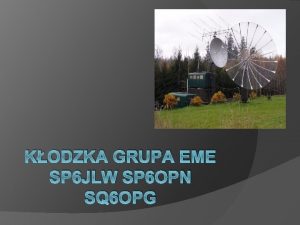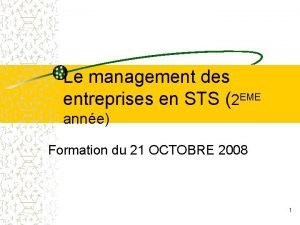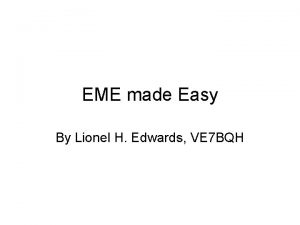Using the SDRIQ for EME Using the SDRIQ






















- Slides: 22

Using the SDR-IQ for EME

Using the SDR-IQ for EME Application to random QSO’s with JT 65 by Edward Cole – KL 7 UW Recent years have seen increasing use of computers in the EME station: • Antenna Control / Tracking Software • Radio Control • Design and Engineering Analysis Tools • DSP • Waterfall & Spectrum Displays • Digital Modes • Migration to Internet scheduling: e-mail & loggers • Software Defined Radios

Software Defined Radios Amateur Radio is beginning to experiment with SDR’s (software defined radios): • Recent Examples: SDR-14, SDR-1000, DSP-10, USRP, FLEX-5000 • Fall 2006 RFSpace introduced the SDR-IQ; a software defined receiver that covers 500 -Hz to 30 -MHz • Single 3. 75 inch square pcb • Interfaced and powered thru computer’s USB-2. 0 port • 200 Demo Boards offered at end of 2006 for $375 • I had to have one!

The SDR-IQ • Minimal RF hardware; Direct convertion to base-band which is converted to digital data and transferred to the USB port • Entire LF-HF band is sampled at 66. 66 MHz by AD 6620 at 23 bits • 16 bits of I/Q data is transferred • Processed by software to recover virtually any modulation type. • DSP filtering & NB detection


SDR-IQ Specs • Covers 500 -Hz to 30 -MHz in 1 Hz steps • Clipping level > -4 d. Bm • Image Rejection 80 -d. B • IP 3 (typ) +15 -d. B • 5 Vdc at 425 m. A • Ext. Radio control via DB-9 • Open source Active-X • Drivers: Win/Linux/Mac • Network server for remote operation of SDR-IQ • Spurious -80 d. Bfs, -100 typ • • 28 -MHz noise floor -134 d. Bm 28 -MHz MDS-133 d. Bm/Hz No freq drift measured Shielding Test at 20 -MHz: -111 d. BM (5 w @ 25 -feet) -100 d. Bm (50 w @ 25 -feet) • 190 -KHz displayed real-time • Minimum RBW: 0. 75 Hz for BW=190 KHz 0. 031 Hz for BW=5 KHz • Spectravue software provided

Software • RFSpace provides Spectravue for immediate use of the SDR-IQ. • Modes: CW, CWr, SSB, DSB, WBFM, NBFM, AM • Displays: raw signal, 2 D and 3 D spectrum, waterfall, combo 2 D+waterfall, total power, and IQ phase • SW controls: sample size, smoothing, amplitude scale, RF & Demod freq, mode, filter bw, NB and AGC • Alberto, I 2 PHD offers a SDR-IQ driver for Winrad (windows version of Linrad) which is written for weak-signal/EME. • Winrad modes: CW and SSB, only, but with more settings for improved audio reception of weak-signals. • Displays for both are both shown, later • Refer to their websites for more details

Using the SDR-IQ for 144 -MHz EME • To use the SDR-IQ for EME I bought a DEMI 144/28 transverter (only receive side used). • I added a 18 -d. B mmic WBIF amp in between them. • Simulations using a signal generator input to my 2 nd 2 m preamp I get: -18 on JT 65 with -141 d. Bm -26 on JT 65 with -150 d. Bm -28 on JT 65 with -152 d. Bm • The JT 65 readings were obtained with my FT-847 plus soundcard with JT 65 B/Spectra-JT running. • This provided comparison of the SDR-IQ to JT 65

Using the SDR-IQ for 144 -MHz EME Figures 1 -6 are made with the signal generator input: • Fig-1 shows typical JT 65 screen • Fig-2 Winrad, no IF amp, BW=50 KHz, RBW=3. 4 Hz, display is 3 -KHz wide, signal= -150 d. Bm • Fig-3 Winrad plus IF amp, BW=50, RBW=3. 4, display 3 KHz, signal= -166 d. Bm • Fig-4 Winrad BW=50, RBW=54. 3, -150 d. Bm input • Fig-5 Not shown • Fig-6 Winrad BW=100, RBW=1. 7, -150 d. Bm input






Using the SDR-IQ for 144 -MHz EME Figures 7 -12 are actual EME signals: • • • Fig-7 K 6 MYC on JT 65, -21 signal Fig-8 K 6 MYC on Winrad, BW=5 KHz, RBW=2, -17 signal Fig-9 K 6 MYC on Winrad, BW=50, RBW=3. 5, -24 signal Fig-10 WE 9 Y & WQ 5 S on JT 65, -22 and -20 signals Fig-11 WE 9 Y on Winrad, BW=26, RBW=9. 2, -20 signal Fig-12 The 144. 100 -144. 150 MHz EME band at KL 7 UW







SUMMARY Clearly the SDR-IQ will display most JT 65 signals over a wide enough band to cover EME activity and randomly detect digital stations! • Economical viewing of EME sub-band • Up to 100 -KHz displayed on moderately fast computers • Full 190 -KHz with CPU > 2 -GHz. • Enables random digital EME contacts • K 1 JT working on blend of JT 65 and Linrad to decode all stations in 100 KHz band. • Cost $499 with enclosure plus $170 for 144 -to-28 MHz conv. • Limitations are what software designers can think of! • http: //www. kl 7 uw. com/SDR. htm
 J&t tracking
J&t tracking Portaria 292 eme
Portaria 292 eme Eme material
Eme material Giggle inkontinans
Giggle inkontinans Piotr zimmerman
Piotr zimmerman Emevirtual
Emevirtual Vk3um eme planner
Vk3um eme planner Ce a ere a ce a ese
Ce a ere a ce a ese Arecibo eme
Arecibo eme Eme converter
Eme converter Sintesi eme
Sintesi eme Drutuut
Drutuut Dubus eme
Dubus eme Eme material
Eme material Plagg i gamla rom
Plagg i gamla rom Personlig tidbok för yrkesförare
Personlig tidbok för yrkesförare Datumr
Datumr Orubbliga rättigheter
Orubbliga rättigheter Jätte råtta
Jätte råtta Verktyg för automatisering av utbetalningar
Verktyg för automatisering av utbetalningar Ministerstyre för och nackdelar
Ministerstyre för och nackdelar Tillitsbaserad ledning
Tillitsbaserad ledning Vem räknas som jude
Vem räknas som jude
